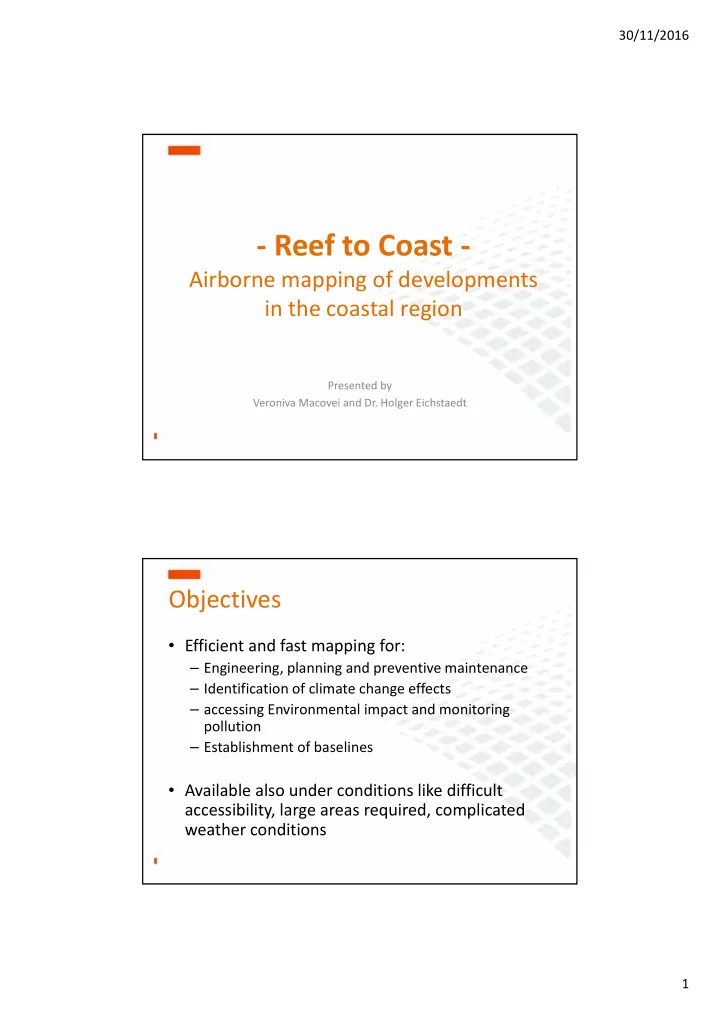

30/11/2016 ‐ Reef to Coast ‐ Airborne mapping of developments in the coastal region Presented by Veroniva Macovei and Dr. Holger Eichstaedt Objectives • Efficient and fast mapping for: – Engineering, planning and preventive maintenance – Identification of climate change effects – accessing Environmental impact and monitoring pollution – Establishment of baselines • Available also under conditions like difficult accessibility, large areas required, complicated weather conditions 1
30/11/2016 Technical solution • Multisensory airborne approach combining required sensors in one flight: – Topographic and bathymetric airborne Lidar systems with full waveform data collection – Hyperspectral sensors in different bands (reflective VNIR and SWIR, thermal LWIR) – Multiple digital camera systems – Airborne Radar in different bands • Guided through GPS and all data orientated by GNSS and Inertial systems Positioning of the technical solution of airborne operations • Between satellite scale – better spatial and spectral resolution for direct engineering and mitigation work – but higher costs than satellites • and UAV scale – more and calibrated sensors – working under more complex weather conditions – efficient also above 3 sqkm 2
30/11/2016 Technical solution Technical solution 3
30/11/2016 Technical solution • Multisensory airborne approach combining required sensors in one flight: – Topographic and bathymetric airborne Lidar systems with full waveform data collection – Hyperspectral sensors in different bands (reflective VNIR and SWIR, thermal LWIR) – Multiple digital camera systems – Airborne Radar in different bands • Guided through GPS and all data orientated by GNSS and Inertial systems Technical solution • Data processing: – With or without ground control point – Accuracies for Lidar data within 10cm for topography and 20cm for bathymetry – Image and hyperspectral data with between 0.5 and 1.5 pixel accuracy (0.03 to 3m depending on sensor and – Airborne Radar in different bands 0.5 to 3m accuracy • Data fusion to object based approaches, 3D objects and thematic maps according to client request 4
30/11/2016 Results and Examples ‐ 1 • Combined bathymetric/topographic mapping of the aquatic interface using a dual frequency Lidar solution for planning, infrastructure, estimation of climate change effects and flood modelling – Dual Lidar green in 634nm and IR in 1550nm – Flying height: 600m – Swath width (overlap 30%): 350m – Penetration: 1 to 1.5 Secchi depth – Point densities: 1 per sqm for bathymetry, 8 per sqm for topography • Productivity: approx. 15 to 30 sqkm/flight hour • Sending two Laser beams out – green for water depth – infrared for topographic mapping 5
30/11/2016 Accuracy considerations and ground 6
30/11/2016 7
30/11/2016 Results and Examples ‐ 2 • Integration of Hyperspectral VNIR into the solution for mapping of Reef conditions, vegetation, chlorophyll, turbidity and water pollution – Flying height: still 600m – Same flight as dual Lidar solution – Spectral resolution: 160 bands in 400 to 1000nm – Spatial resolution: 0.3 to 0.5m Marine System ‐ Coral Reef Example • A true color image of îlot Maître – New Caledonia (based on VNIR Hyperspectral data) 8
30/11/2016 Spectral difference Decision Tree final classification result 9
30/11/2016 Further analysis Different coral group can be extracted for further analysis Ground truth will be needed for coral group identification Turbidity Example More turbid Less turbid 10
30/11/2016 Chlorophyll ‐ a Lower concentration Higher concentration Total Phosphorus (TP) ‐ îlot Maître (NC) Lower concentration Higher concentration 11
30/11/2016 Incident Mapping ‐ Pellets Pollution Example • pellets (also other plastic components) With laboratory results, a spectral • library is built and pellets detection is performed • Detection results have been proven to show pellets distribution 12
30/11/2016 Results and Examples ‐ 3 • Integration of Hyperspectral VNIR and SWIR into the solution for mapping of land vegetation, soils, detailed land use, forestry and agricultural parameters, geotechnical facts, pollution on land – Flying height: still 600m – Same flight as dual Lidar solution – Spectral resolution: 416 bands in 400 to 2500nm – Spatial resolution: 1m Forestry Map 13
30/11/2016 Forestry Map Heavy metal pollution 14
30/11/2016 Mineral and Mining maps Results and Examples ‐ 4 • Integration of thermal broadband or hyperspectral for polluter analysis – Flying height: still 600m (for broadband), 1000+m for thermal hyperspectral – Same flight as dual Lidar solution (for thermal hyperspectral additional flight) – Spectral resolution: 130 bands in 7800 to 11800nm – Thermal resolution: better 0.018K – Spatial resolution: 1m 15
30/11/2016 Industrial pollution Changes in water temperature identified Domestic pollutions and freshwater seapages 16
30/11/2016 Analysis of pollution effects along the coast line The ship berthed at the wharf prevents the warmer water drifting northwards Warmer water collects against the shoreline Thanks for your attention and please feel free to ask any question Holger@helipro.com.fj 17
Recommend
More recommend